
Copyright 2014 by Telamon Press, Berkeley, California No part of this publication may be reproduced, stored in a retrieval system, or transmitted in any form or by any means, electronic, mechanical, photocopying, recording, scanning, or otherwise, except as permitted under Section 107 or 108 of the 1976 United States Copyright Act, without the prior written permission of the publisher. Requests to the publisher for permission should be addressed to the Permissions Department, Telamon Press, 918 Parker St., Suite A-12, Berkeley, CA 94710. Limit of Liability/Disclaimer of Warranty: The publisher and the author make no representations or warranties with respect to the accuracy or completeness of the contents of this work and specifically disclaim all warranties, including without limitation warranties of fitness for a particular purpose. No warranty may be created or extended by sales or promotional materials. The advice and strategies contained herein may not be suitable for every situation. This work is sold with the understanding that the publisher is not engaged in rendering medical, legal, or other professional advice or services.
If professional assistance is required, the services of a competent professional person should be sought. Neither the publisher nor the author shall be liable for damages arising herefrom. The fact that an individual, organization, or website is referred to in this work as a citation and/or potential source of further information does not mean that the author or the publisher endorses the information the individual, organization, or website may provide or recommendations they/it may make. Further, readers should be aware that Internet websites listed in this work may have changed or disappeared between when this work was written and when it is read. For general information on our other products and services or to obtain technical support, please contact our Customer Care Department within the United States at (866) 744-2665, or outside the United States at (510) 253-0500. Telamon Press publishes its books in a variety of electronic and print formats.
Some content that appears in print may not be available in electronic books, and vice versa. TRADEMARKS: Telamon Press and the Telamon Press logo are trademarks or registered trademarks of Callisto Media Inc. and/or its affiliates, in the United States and other countries, and may not be used without written permission. All other trademarks are the property of their respective owners. Telamon Press is not associated with any product or vendor mentioned in this book. ISBN: Print 978-1-62315-345-8| eBook 978-1-62315-346-5 Introduction W elcome to The Quick & Easy Paleo Cookbook. Whether youve picked up this book because you want to lose weight, or you simply want to feel better, youve come to the right place.
The Paleo diet offers these benefits and more. The Paleo diet is based on the idea that our bodies, which evolved over millions of years to ingest a hunter-gatherer diet, simply cant tolerate the modern diets low-nutrient, highly refined carbohydrates and toxic chemicals. By eating in a way that mimics the way our ancestors ate before the agricultural and industrial revolutions, Paleo diet followers hope to optimize their health while minimizing the risk of chronic disease. In the process, many find that they also experience other benefits:
- Weight loss
- Clearer skin and elimination of skin conditions like eczema
- Lowered blood pressure and reduced symptoms of chronic illnesses such as type 2 diabetes, rheumatoid arthritis, and celiac disease
- Reduced allergic reactions
- Elimination of bothersome digestive symptoms such as gas, bloating, diarrhea, and constipation
The Quick & Easy Paleo Cookbook is filled with information that will help you incorporate the Paleo diet into your life with ease. You will gain a full understanding of the theory behind the Paleo diet and youll have the information you need to adopt the diet yourself. While many Paleo cookbooks and websites rely on complicated or time-consuming cooking techniques and expensive or hard-to-find ingredients, this book provides recipes that are, as the title states, quick and easy to make, and that use ingredients that are both affordable and commonly available.
And all the recipes in the book can be prepared in 30 minutes or less. The book is divided into two parts. provides you with all the basics of the Paleo diet. It examines the Paleo way of eating and the related health benefits. It also provides a detailed guide to getting started on the Paleo diet, including lists of which foods to eat and which to avoid, and advice on meal planning, stocking your pantry, and cooking quick and delicious meals that adhere to the plan. offers seventy-seven quick and easy recipes that follow the Paleo diet guidelines.
These dishes are a cinch to make, highly nutritious, and full of flavor. With these recipes in hand, youll begin your Paleo diet eating delicious and satisfying meals.  PART ONE Getting Started
PART ONE Getting Started 
 CHAPTER ONE The Basics of the Paleo Diet In its most basic terms, the Paleo diet is a diet that mimics the eating habits of our ancestors. This means a diet consisting of whole, minimally processed foods that could have been gathered or hunted in our ancestors immediate environs. While its true that to adopt the Paleo diet, youll need to overhaul the way you eat and think about food, this book will make it easy. WHAT IS THE PALEO DIET? Often referred to as the caveman diet, primal diet, or Paleolithic diet, the Paleo diet resembles the eating habits of the early humans who populated Earth. WHAT IS THE PALEO DIET? Often referred to as the caveman diet, primal diet, or Paleolithic diet, the Paleo diet resembles the eating habits of the early humans who populated Earth.
CHAPTER ONE The Basics of the Paleo Diet In its most basic terms, the Paleo diet is a diet that mimics the eating habits of our ancestors. This means a diet consisting of whole, minimally processed foods that could have been gathered or hunted in our ancestors immediate environs. While its true that to adopt the Paleo diet, youll need to overhaul the way you eat and think about food, this book will make it easy. WHAT IS THE PALEO DIET? Often referred to as the caveman diet, primal diet, or Paleolithic diet, the Paleo diet resembles the eating habits of the early humans who populated Earth. WHAT IS THE PALEO DIET? Often referred to as the caveman diet, primal diet, or Paleolithic diet, the Paleo diet resembles the eating habits of the early humans who populated Earth.
These people didnt have agriculture. They didnt cultivate crops or mill grains. They didnt eat refined sugars, grains, dairy, oils, or any of the highly processed foods that are so common today. And so they probably did not suffer from modern-day diseases like type 2 diabetes, obesity, and cardiovascular disease. These early humans subsisted on a diet made up of whatever foods they could find in their natural environment: free-range meats, fish, nuts, seeds, fruits, and vegetables. In other words, they ate unprocessed, seasonal, local, organic, whole foods.
But around ten thousand years ago, many humans settled in groupsfor support, companionship, safety, and other reasonsand they began to cultivate vegetables and domesticate animals for their food. These people were no longer wandering the land in search of their next meal. They became more sedentary, and learned to refine grains and other foods in order to have a predictable, easily accessible, and convenient source of nutrition. The downside of all this newfound convenience is that the changes in the human diet, combined with reduced physical activity, have caused us to become increasingly overweight and plagued by diseases. The theory behind the Paleo diet is that we humans simply havent adapted to eating all of these highly processed foods. These processed foods, Paleo proponents assert, cause inflammation at the cellular level, promoting disease.

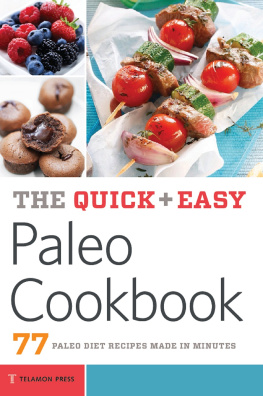


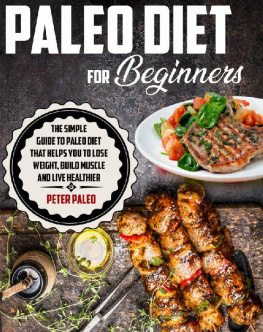
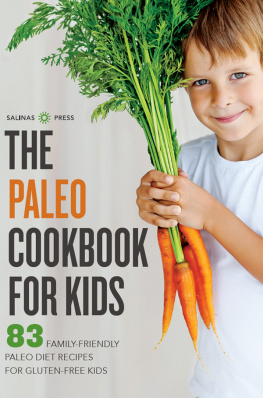
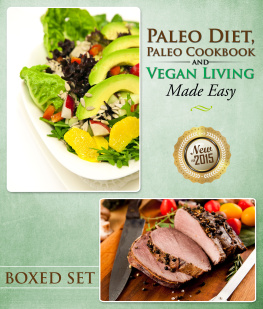
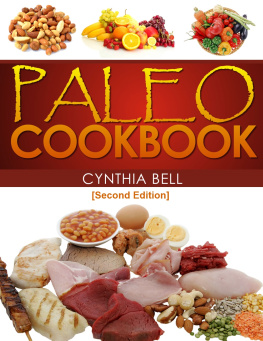
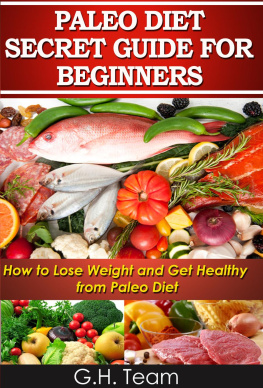


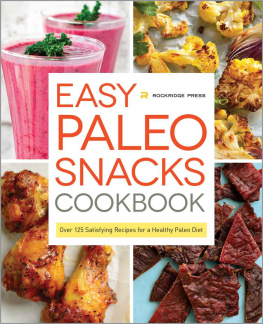


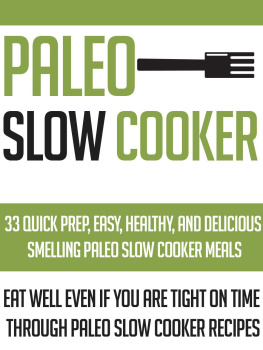
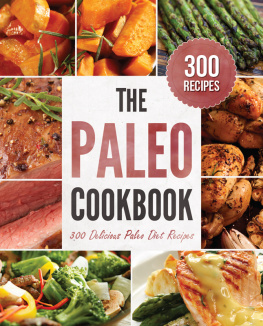

 PART ONE Getting Started
PART ONE Getting Started 
 CHAPTER ONE The Basics of the Paleo Diet In its most basic terms, the Paleo diet is a diet that mimics the eating habits of our ancestors. This means a diet consisting of whole, minimally processed foods that could have been gathered or hunted in our ancestors immediate environs. While its true that to adopt the Paleo diet, youll need to overhaul the way you eat and think about food, this book will make it easy. WHAT IS THE PALEO DIET? Often referred to as the caveman diet, primal diet, or Paleolithic diet, the Paleo diet resembles the eating habits of the early humans who populated Earth. WHAT IS THE PALEO DIET? Often referred to as the caveman diet, primal diet, or Paleolithic diet, the Paleo diet resembles the eating habits of the early humans who populated Earth.
CHAPTER ONE The Basics of the Paleo Diet In its most basic terms, the Paleo diet is a diet that mimics the eating habits of our ancestors. This means a diet consisting of whole, minimally processed foods that could have been gathered or hunted in our ancestors immediate environs. While its true that to adopt the Paleo diet, youll need to overhaul the way you eat and think about food, this book will make it easy. WHAT IS THE PALEO DIET? Often referred to as the caveman diet, primal diet, or Paleolithic diet, the Paleo diet resembles the eating habits of the early humans who populated Earth. WHAT IS THE PALEO DIET? Often referred to as the caveman diet, primal diet, or Paleolithic diet, the Paleo diet resembles the eating habits of the early humans who populated Earth.